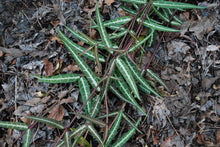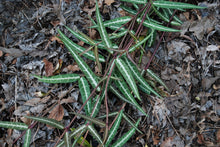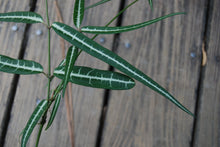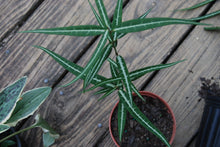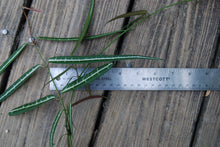Hemidesmus indicus
Regular price
$25.00
Sale
Indian Sarsaparilla. I was first introduced to this species by Scott McMahan of McMahan's Nursery, Clermont, GA, who collected it in northern Vietnam, and then Mark Weathington of the J.C. Raulston Arboretum in Raleigh, NC, who collected it almost simultaneously in Taiwan. No one really knew what to call it, thinking that it might be a species of Trachelospermum and then later changing this to Euonymus. It would develop adventitious roots along its stems similar to Euonymus fortunei, but we had yet to see it flower. But now we know that it is Hemidesmus indicus in the family Apocynaceae with Trachelospermum, Oleander, Adenium, and many more familiar genera. In southern Asia it is a prominent medicinal herb and if one wishes to know more, just "Google" the name and find that its uses are manifold. The leaf really resembles a Euonymus fortunei 'Wolong's Ghost' on steroids. I have measured leaves up to 6" long with the prominent silver marking along the midrib for the length of the leaf. Under certain conditions, like more sun, the silver veining is lost to a totally green leaf, but lower light level induces the silver "variegation." Since we grow it in more sun, your plant could be all green when you receive it. We are not sure of its ultimate cold hardiness, but it has been growing outside in Raleigh, NC, for a couple of winters with no ill effects. In its native haunts, it can be seen growing up tree trunks in a fashion similar to Ivy with aerial roots attaching themselves to most any textured surface. Here is what Wikipedia says about its uses: "It is used to make beverages and also used in traditional medicine. In Ayurveda it goes by the name of Ananthamoola or Anantmula. It is also called the False Sarsaparilla. The plant enjoys a status as tonic, alterative, demulcent, diaphoretic, diuretic and blood purifier. It is employed in nutritional disorders, syphilis, chronic rheumatism, gravel and other urinary diseases and skin affections. It is administered in the form of powder, infusion or decoction as syrup. It is also a component of several medicinal preparations. I put a plant of this plant in a recent silent auction at a plant conference in Raleigh, NC, and it went for $170.00 in a one quart pot, the same size that you will receive. Another in depth article can be found here: http://www.disabled-world.com/artman/publish/hemidesmus-indicus.shtml. The silver central band usually occurs on the new growth in the spring with succeeding flushes being all green.






